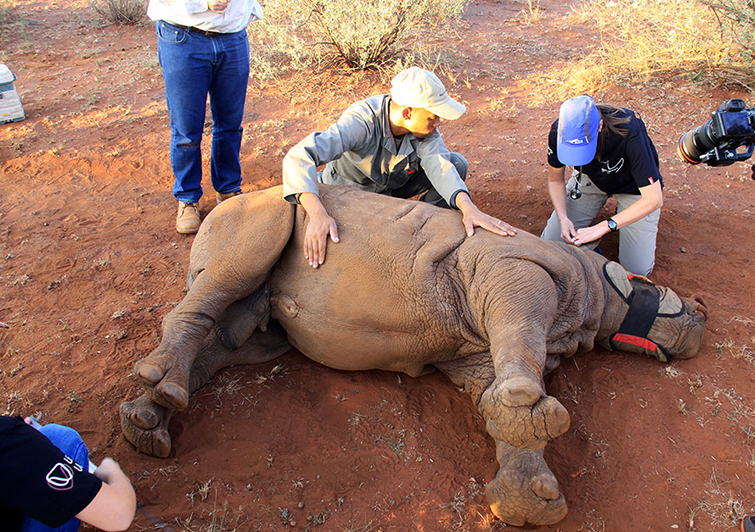06 June 2019
|
Story Leonie Bolleurs
 An interdisciplinary team of researchers from the University of the Free State (UFS) has launched a project this year to prolong the survival of rhino through pro-active captivity and relocation.
An interdisciplinary team of researchers from the University of the Free State (UFS) has launched a project this year to prolong the survival of rhino through pro-active captivity and relocation.
You are lying in a hammock in a jungle in the Ujung Kulon National Park in Indonesia. Insects descend on you, but you are unable to do anything about it, because using an insect repellent might cost you the opportunity to see the last Javan rhinoceros.
The last rhinocerosThis animal, of which there are only an estimated 35 left on the planet, is on the Red List of critically endangered species of the
International Union for Conservation of Nature (IUCN).
In South Africa, however, the picture looks a bit brighter; there are an estimated 15 000 rhinos left, most of which are in captivity in an attempt to prevent further decline.
But what is needed to ensure that there will be rhinos left in five to ten years’ time?
Proactive actionA group of researchers from the University of the Free State, coordinated by
Dr Francois Deacon from the
Department of Animal, Wildlife and Grassland Sciences, have launched an interdisciplinary project last year. The focus of the project, with the title: Ecological and biological factors regulating rhino, is on establishing a conservation model through research and teaching which could be used as an example in other countries.
The team’s aim is to act proactively through a process of captivity and relocation in order to prolong the survival of this endangered species.
Since 2011, Dr Deacon has been doing pioneering research on giraffes by equipping the animals with harnesses in order to monitor them in their natural habitat. Various aspects of the animals have been investigated, including the ecological and biological factors regulating giraffes in their natural habitat.
Much success has been achieved with these studies, and similar factors will be researched in rhinos. This will, inter alia, assist in formulating inter-calving periods, milk formulas, and feeding rations, and it will shed light on aspects such as medicine, diseases, parasites, as well as understanding and managing problems with detention.
Biggest project of its kindData from 750 rhino across South Africa will be collected. This project which the team has embarked on, is the biggest of its kind ever.
Some of the rhino will even be equipped with the harnesses to monitor them in their environment.
Each researcher in the interdisciplinary team, together with their students, will collect data during routine procedures on game farms; for instance, when the animals are moved or during treatment. The animals are the property of private game farmers.
In the various disciplines,
Dr Frans O'Neill,
Prof Trudi O'Neill,
Dr Olihile Sebolai, and
Dr Carlien Pohl from the
Department of Microbial, Biochemical and Food Biotechnology, will focus their studies on, inter alia, yeasts and bacteria. Hennie Butler in the Department of Zoology will investigate dehorning and the impact it has on the social behaviour of the animals.
Prof Paul Grobler and
Dr Karen Ehlers in the
Department of Genetics will, among other things, focus on the diversification of genes. Prof Garry Osthoff in the Department of Microbial, Biochemical and Food Biotechnology will look at the milk quality of rhinos by, among others, studying fatty-acid content and cholesterol. In Animal, Wildlife and Grassland Sciences, Dr Deacon will, among others, investigate the sexual maturity of the animal and also how fast the calf is growing – where data between a calf in captivity and a free-ranging calf will be compared. Prof Felicity Burt from the Department of Virology and Dr Angel Valverde from the SAENSE group will also take part in the study.
Hardened for survivalThe findings of the project will help to answer questions related to rhino farming. Currently, game farmers are taking care of between 50 and 60% of rhino in private captivity. Although the prediction is that rhino would in future be kept in smaller areas within highly protected reserves rather than in bigger areas which could not be controlled, the team’s research is focused on breeding a hardened animal that could eventually survive in the wild following relocation.
Video: Rockwood Private Game Reserve